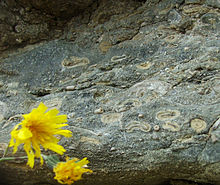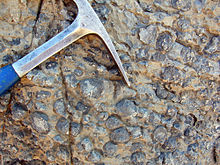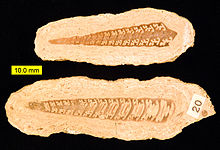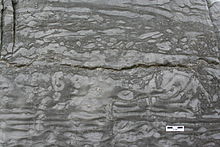- Oncolite
-
 Oncolites from the upper Burgsvik beds (Silurian), with shell fragments as nuclei. Large flower is 2 cm in diameter.
Oncolites from the upper Burgsvik beds (Silurian), with shell fragments as nuclei. Large flower is 2 cm in diameter.
 Oncolites in the Alamo bolide impact breccia (Guilmette Formation, Late Devonian, Frasnian) near Hancock Summit, Pahranagat Range, Nevada.
Oncolites in the Alamo bolide impact breccia (Guilmette Formation, Late Devonian, Frasnian) near Hancock Summit, Pahranagat Range, Nevada.
Oncolites are sedimentary structures formed out of oncoids, which are layered spherical growth structures formed by cyanobacterial growth. Oncolites are very similar to stromatolites, but instead of forming columns they form approximately spherical structures.[1] Often the oncoids form around a central nucleus, such as a shell particle,[2] and the calcium carbonate structure is precipitated by encrusting microbes. Oncolites are indicators of warm waters in the photic zone, but are also known in contemporary freshwater environments.[3] These structures rarely exceed 10 cm in diameter.
 Oncolites formed around the Middle Jurassic gastropod Bactroptyxis trachaea (Normandy, France).
Oncolites formed around the Middle Jurassic gastropod Bactroptyxis trachaea (Normandy, France).
References
- ^ Corsetti, F.A.; Awramik, S.M.; Pierce, D. (2003-04-15). "A complex microbiota from snowball Earth times: Microfossils from the Neoproterozoic Kingston Peak Formation, Death Valley, USA". Proceedings of the National Academy of Sciences 100 (8): 4399–4404. doi:10.1073/pnas.0730560100. PMC 153566. PMID 12682298. http://www.pnas.org/cgi/content/abstract/100/8/4399. Retrieved 2007-06-28.
- ^ Gutschick, R.C.; Perry, T.G. (1959-11-01). "Sappington (Kinderhookian) sponges and their environment [Montana"]. Journal of Paleontology 33 (6): 977–985. http://jpaleontol.geoscienceworld.org/cgi/content/abstract/33/6/977. Retrieved 2007-06-28.
- ^ Riding, Robert. 1991. Calcareous Algae and Stromatolites, pp 32. Springer-Verlag Press.
Categories:- Sedimentary rocks
- Trace fossils
- Paleontology stubs
Wikimedia Foundation. 2010.

